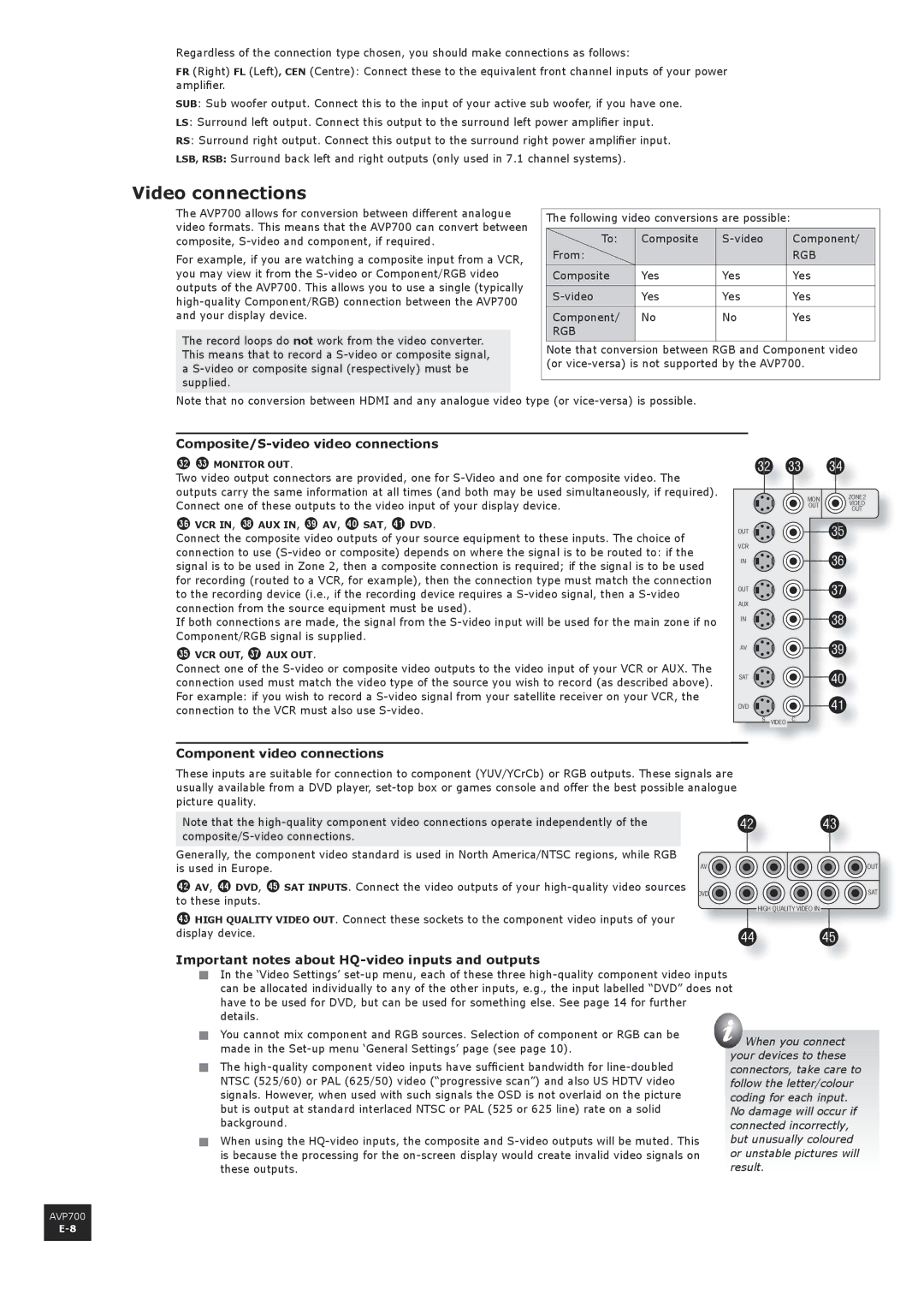
Regardless of the connection type chosen, you should make connections as follows:
FR (Right) FL (Left), CEN (Centre): Connect these to the equivalent front channel inputs of your power amplifier.
SUB: Sub woofer output. Connect this to the input of your active sub woofer, if you have one.
LS: Surround left output. Connect this output to the surround left power amplifier input.
RS: Surround right output. Connect this output to the surround right power amplifier input.
LSB, RSB: Surround back left and right outputs (only used in 7.1 channel systems).
Video connections
The AVP700 allows for conversion between different analogue video formats. This means that the AVP700 can convert between composite,
For example, if you are watching a composite input from a VCR, you may view it from the
The record loops do not work from the video converter. This means that to record a
The following video conversions are possible:
To: | Composite | Component/ | |
From: |
|
| RGB |
Composite | Yes | Yes | Yes |
Yes | Yes | Yes | |
Component/ | No | No | Yes |
RGB |
|
|
|
Note that conversion between RGB and Component video (or
Note that no conversion between HDMI and any analogue video type (or
Composite/S-video video connections
dm dn MONITOR OUT.
Two video output connectors are provided, one for
dq VCR IN, ds AUX IN, dt AV, ek SAT, el DVD.
Connect the composite video outputs of your source equipment to these inputs. The choice of connection to use
If both connections are made, the signal from the
dp AUX OUT.
Connect one of the
Component video connections
�� �� ��
MON | ZONE2 | |
OUT | VIDEO | |
OUT | ||
|
OUT ![]()
![]() ��
��
VCR
IN ![]()
![]() ��
��
OUT ![]()
![]() ��
��
AUX
IN ![]()
![]() ��
��
AV ![]()
![]() ��
��
SAT ![]()
![]() ��
��
DVD ![]()
![]() ��
��
S VIDEO C
These inputs are suitable for connection to component (YUV/YCrCb) or RGB outputs. These signals are usually available from a DVD player,
Note that the | �� | �� | |||
|
|
|
| ||
|
|
|
| ||
|
|
|
| ||
Generally, the component video standard is used in North America/NTSC regions, while RGB |
|
|
|
| |
|
|
|
| ||
is used in Europe. | AV |
|
| ||
em AV, eo DVD, ep SAT INPUTS. Connect the video outputs of your | DVD |
|
| ||
to these inputs. |
| HIGH QUALITY VIDEO IN |
| ||
en HIGH QUALITY VIDEO OUT. Connect these sockets to the component video inputs of your |
|
| |||
�� | �� | ||||
display device. | |||||
|
|
|
| ||
Important notes about HQ-video inputs and outputs
< In the ‘Video Settings’ |
can be allocated individually to any of the other inputs, e.g., the input labelled “DVD” does not |
have to be used for DVD, but can be used for something else. See page 14 for further |
OUT
SAT
details. |
<You cannot mix component and RGB sources. Selection of component or RGB can be made in the
<The
<When using the
![]() When you connect your devices to these connectors, take care to follow the letter/colour coding for each input. No damage will occur if connected incorrectly, but unusually coloured or unstable pictures will result.
When you connect your devices to these connectors, take care to follow the letter/colour coding for each input. No damage will occur if connected incorrectly, but unusually coloured or unstable pictures will result.
AVP700
